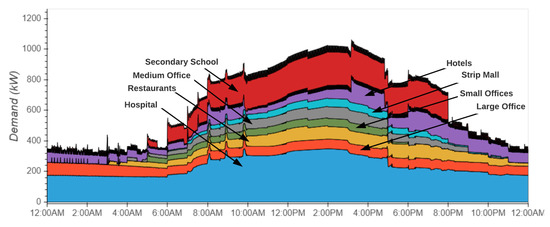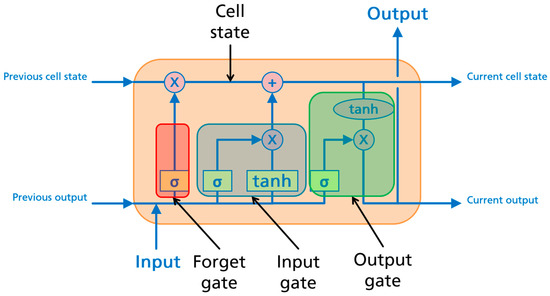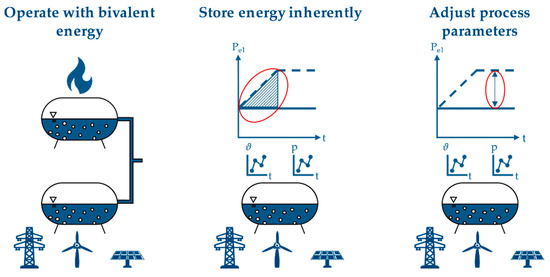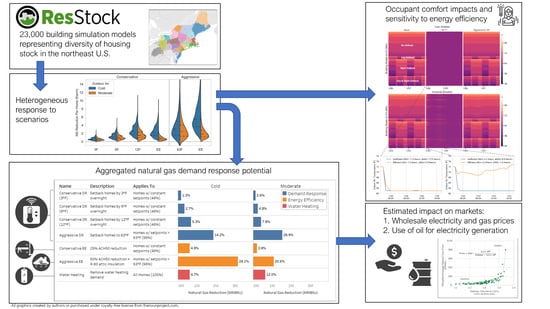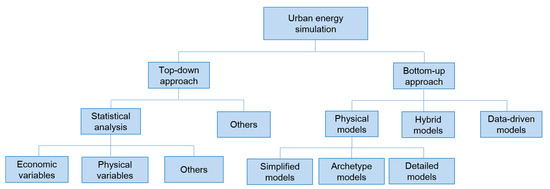Demand Management for Buildings and Industrial Facilities
Share This Topical Collection
Editors
 Dr. J. Rene Villalobos
Dr. J. Rene Villalobos
 Dr. J. Rene Villalobos
Dr. J. Rene Villalobos
E-Mail
Website
Collection Editor
School of Informatics, Computing and Decision Systems, Arizona State University, P.O. Box 878809,Tempe, AZ 85287-8809, USA
Interests: energy demand side management; energy system optimization; energy in manufacturing
Special Issues, Collections and Topics in MDPI journals
 Dr. Ryan J. Milcarek
Dr. Ryan J. Milcarek
 Dr. Ryan J. Milcarek
Dr. Ryan J. Milcarek
E-Mail
Website
Collection Editor
School for Engineering of Matter, Transport and Energy, Arizona State University, Tempe, AZ 85287-6106, USA
Interests: fuel cells; combustion; combined heat and power; thermodynamics; energy efficiency and emissions reduction
Topical Collection Information
Dear Colleagues,
Matching aggregate electric demand of all energy users with the supply is an ongoing and challenging practice associated with a centralized generation. The rapid growth of renewable generation expected in the coming decades makes it more difficult to predict demand and increasingly requires rapid cycling of power plants. Service providers can influence energy user’s behavior by implementing demand-side management practices, such as time-of-use price tariffs. Energy users can adjust their behavior to meet their energy requirements while minimizing energy costs.
Among the various energy users, building systems currently contribute to a significant portion of the total electric load and load fluctuations. Industrial facilities, in particular, often have large systems that can create significant changes in user demand in short time periods. Industrial facilities also have unique infrastructure and energy storage capabilities that can be deployed in demand response.
This Topic Collection is focused on advances in demand management for buildings and industrial facilities. Submissions are encouraged but not limited to the following general areas.
- Demand management for buildings
- Industrial demand response
- Energy storage in buildings
- Energy storage in manufacturing
- Thermal energy storage and demand response
- Innovative pricing mechanisms for demand response
- Greenhouse gas emissions and demand response
- Renewable energy and demand response
This issue will bring together recent research in an effort to identify new opportunities and advance the field.
Prof. Dr. Patrick Phelan
Dr. J. Rene Villalobos
Dr. Ryan J. Milcarek
Collection Editors
Manuscript Submission Information
Manuscripts should be submitted online at www.mdpi.com by registering and logging in to this website. Once you are registered, click here to go to the submission form. Manuscripts can be submitted until the deadline. All submissions that pass pre-check are peer-reviewed. Accepted papers will be published continuously in the journal (as soon as accepted) and will be listed together on the collection website. Research articles, review articles as well as short communications are invited. For planned papers, a title and short abstract (about 100 words) can be sent to the Editorial Office for announcement on this website.
Submitted manuscripts should not have been published previously, nor be under consideration for publication elsewhere (except conference proceedings papers). All manuscripts are thoroughly refereed through a single-blind peer-review process. A guide for authors and other relevant information for submission of manuscripts is available on the Instructions for Authors page. Energies is an international peer-reviewed open access semimonthly journal published by MDPI.
Please visit the Instructions for Authors page before submitting a manuscript.
The Article Processing Charge (APC) for publication in this open access journal is 2600 CHF (Swiss Francs).
Submitted papers should be well formatted and use good English. Authors may use MDPI's
English editing service prior to publication or during author revisions.
Keywords
- Demand side management
- Demand response
- Industrial facilities
- Buildings and demand response
- Energy storage and demand response
- Manufacturing and demand response
Published Papers (7 papers)
Open AccessArticle
Demand-Side Flexibility Impact on Prosumer Energy System Planning
by
Marko Jelić, Marko Batić and Nikola Tomašević
Cited by 11 | Viewed by 3693
Abstract
Apart from numerous technical challenges, the transition towards a carbon-neutral energy supply is greatly hindered by limited economic feasibility of renewable energy sources. This results in their slow and bounded penetration in both commercial and residential sectors that are responsible for over 40%
[...] Read more.
Apart from numerous technical challenges, the transition towards a carbon-neutral energy supply is greatly hindered by limited economic feasibility of renewable energy sources. This results in their slow and bounded penetration in both commercial and residential sectors that are responsible for over 40% of final energy consumption. This paper aims to demonstrate that combined application of sophisticated planning methodologies at building-level and presents incentive mechanisms for renewables that can result in prosumers, featuring hybrid renewable energy systems (HRES), with economic performance comparable to that of conventional energy systems. The presented research enhances existing planning methodologies by integrating appliance-level demand side management into the decision process and investigates its effect on the planning problem. Moreover, the proposed methodology features an innovative and holistic approach that simultaneously assess electrical and thermal domain in both an isolated and grid-connected context. The analyzed hybrid system consists of solar photovoltaic, wind turbine and battery with thermal supply featuring solar thermal collector and a ground-source heat pump. Overall optimization problem is modeled as a mixed-integer linear program, while ranking of all feasible alternatives is made by the multicriteria decision-making algorithm against several technological, economic, and environmental criteria. A real-life scenario of energy system retrofit for a building in the United Kingdom was employed to demonstrate overall cost savings of 12% in the present market and regulation context.
Full article
►▼
Show Figures
Open AccessArticle
Improved Air-Conditioning Demand Response of Connected Communities over Individually Optimized Buildings
by
Nicolas A. Campbell, Patrick E. Phelan, Miguel Peinado-Guerrero and Jesus R. Villalobos
Cited by 2 | Viewed by 2204
Abstract
Connected communities potentially offer much greater demand response capabilities over singular building energy management systems (BEMS) through an increase of connectivity. The potential increase in benefits from this next step in connectivity is still under investigation, especially when applied to existing buildings. This
[...] Read more.
Connected communities potentially offer much greater demand response capabilities over singular building energy management systems (BEMS) through an increase of connectivity. The potential increase in benefits from this next step in connectivity is still under investigation, especially when applied to existing buildings. This work utilizes EnergyPlus simulation results on eight different commercial prototype buildings to estimate the potential savings on peak demand and energy costs using a mixed-integer linear programming model. This model is used in two cases: a fully connected community and eight separate buildings with BEMS. The connected community is optimized using all zones as variables, while the individual buildings are optimized separately and then aggregated. These optimization problems are run for a range of individual zone flexibility values. The results indicate that a connected community offered
and
more peak demand savings for low and high flexibility scenarios, relative to individually optimized buildings. Energy cost optimization results show only marginally better savings of
and
for low and high flexibility, respectively.
Full article
►▼
Show Figures
Open AccessArticle
A Forecast-Based Load Management Approach for Commercial Buildings Demonstrated on an Integration of BEV
by
Thomas Steens, Jan-Simon Telle, Benedikt Hanke, Karsten von Maydell, Carsten Agert, Gian-Luca Di Modica, Bernd Engel and Matthias Grottke
Cited by 3 | Viewed by 2334
Abstract
Load-forecasting problems have already been widely addressed with different approaches, granularities and objectives. Recent studies focused not only on deep learning methods but also on forecasting loads on single building level. This study aims to research problems and possibilities arising by using different
[...] Read more.
Load-forecasting problems have already been widely addressed with different approaches, granularities and objectives. Recent studies focused not only on deep learning methods but also on forecasting loads on single building level. This study aims to research problems and possibilities arising by using different load-forecasting techniques to manage loads. For that behavior of two neural networks, Long Short-Term Memory and Feed-Forward Neural Network as well as two statistical methods, standardized load profiles and personalized standardized load profiles are analyzed and assessed by using a sliding-window forecast approach. The results show that personalized standardized load profiles (MAE: 3.99) can perform similar to deep learning methods (for example, LSTM MAE: 4.47). However, because of the simplistic approach, load profiles are not able to adapt to new patterns. As a case study for evaluating the support of load-forecasting for applications in energy management systems, the integration of charging stations into an existing building is simulated by using load-forecasts to schedule the charging procedures. It is shown that forecast- based controlled charging can have a significant impact by lowering overload peaks exceeding the house connection point power limit (controlled charging 20.24 kW; uncontrolled charging: 65.15 kW) while slightly increasing average charging duration. It is concluded that integration of high flexible loads can be supported by using forecast-based energy management systems with regards to their limitations.
Full article
►▼
Show Figures
Open AccessArticle
Investigating the Electrical Demand-Side Management Potential of Industrial Steam Supply Systems Using Dynamic Simulation
by
Fabian Borst, Nina Strobel, Thomas Kohne and Matthias Weigold
Cited by 10 | Viewed by 2439
Abstract
The increasing share of volatile, renewable energies, such as wind and solar power, leads to challenges in the stabilization of power grids and requires more flexibility in future energy systems. This article addresses the flexibilization of the consumer side and presents a simulation-based
[...] Read more.
The increasing share of volatile, renewable energies, such as wind and solar power, leads to challenges in the stabilization of power grids and requires more flexibility in future energy systems. This article addresses the flexibilization of the consumer side and presents a simulation-based method for the technical and economic investigation of energy flexibility measures in industrial steam supply systems. The marketing of three different energy-flexibility measures—bivalence, inherent energy storage and adjusting process parameters—both at the spot market and at the balancing power market, are investigated from a technical as well as an economic point of view. Furthermore, the simulation-based methodology also considers pressure and temperature fluctuation induced by energy-flexibility measures. First, different energy-flexibility measures for industrial steam supply systems are introduced. Then, the physical modeling of the steam generation, distribution, and consumption as well as measure-specific control strategies will be discussed. Finally, the methodology is applied to a steam supply system of a chemical company. It is shown that the investigated industrial steam supply system shows energy-flexibility potentials up to 10 MW at peak and an annual average of 5.6 MW, which highly depend on consumer behavior and flexibility requirements.
Full article
►▼
Show Figures
Open AccessArticle
Residential Natural Gas Demand Response Potential during Extreme Cold Events in Electricity-Gas Coupled Energy Systems
by
Andrew Speake, Paul Donohoo-Vallett, Eric Wilson, Emily Chen and Craig Christensen
Cited by 11 | Viewed by 4013
Abstract
In regions where natural gas is used for both power generation and heating buildings, extreme cold weather events can place the electrical system under enormous stress and challenge the ability to meet residential heating and electric demands. Residential demand response has long been
[...] Read more.
In regions where natural gas is used for both power generation and heating buildings, extreme cold weather events can place the electrical system under enormous stress and challenge the ability to meet residential heating and electric demands. Residential demand response has long been used in the power sector to curtail summer electric load, but these types of programs in general have not seen adoption in the natural gas sector during winter months. Natural gas demand response (NG-DR) has garnered interest given recent extreme cold weather events in the United States; however, the magnitude of savings and potential impacts—to occupants and energy markets—are not well understood. We present a case-study analysis of the technical potential for residential natural gas demand response in the northeast United States that utilizes diverse whole-building energy simulations and high-performance computing. Our results show that NG-DR applied to residential heating systems during extreme cold-weather conditions could reduce natural gas demand by 1–29% based on conservative and aggressive strategies, respectively. This indicates a potential to improve the resilience of gas and electric systems during stressful events, which we examine by estimating the impact on energy costs and electricity generation from natural gas. We also explore relationships between hourly indoor temperatures, demand response, and building envelope efficiency.
Full article
►▼
Show Figures
Open AccessArticle
A Comparison of Various Bottom-Up Urban Energy Simulation Methods Using a Case Study in Hangzhou, China
by
Yanxia Li, Chao Wang, Sijie Zhu, Junyan Yang, Shen Wei, Xinkai Zhang and Xing Shi
Cited by 14 | Viewed by 3100
|
Correction
Abstract
Urban energy simulation can provide valuable information to urban planning, urban energy management, and urban emission reduction. Therefore, urban energy simulation has become an active research discipline. Various urban energy simulation methods and techniques have been developed and applied to cities on different
[...] Read more.
Urban energy simulation can provide valuable information to urban planning, urban energy management, and urban emission reduction. Therefore, urban energy simulation has become an active research discipline. Various urban energy simulation methods and techniques have been developed and applied to cities on different scales. A review is conducted to categorize these methods and techniques and to analyze their pros and cons. Several representative methods and techniques are compared for their data inputs, suitable scales, accuracy, and computing speeds. Hangzhou South Railway Station area, which contains 522 buildings, is used as the case to evaluate the effectiveness and challenges of different urban energy simulation methods.
Full article
►▼
Show Figures







